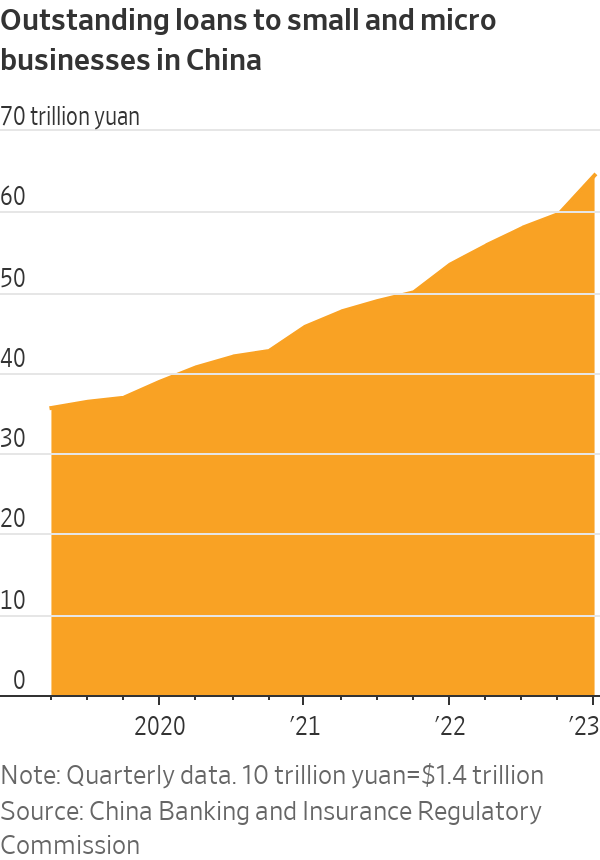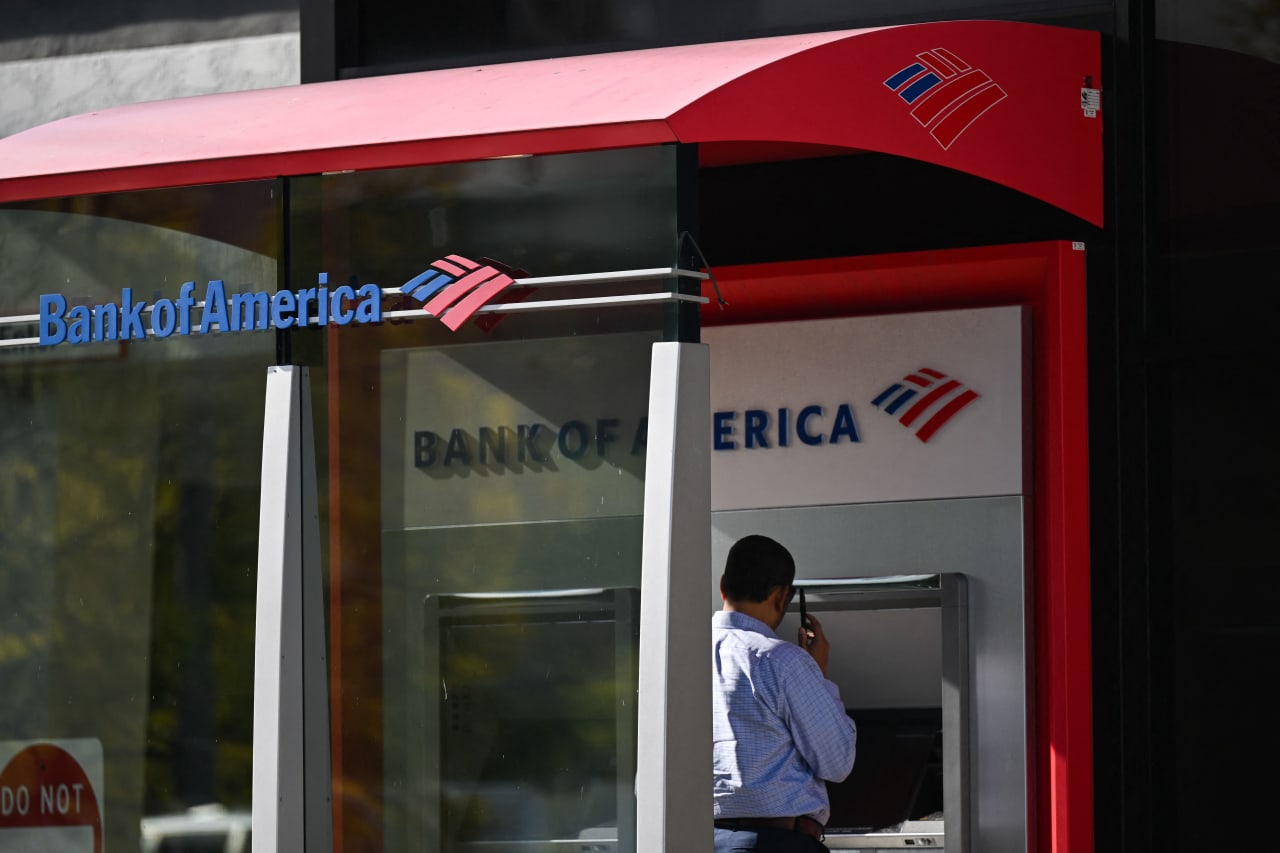China’s Small Businesses Are Hit Hard as Economic Recovery Falters
Beijing pushes banks to extend loans to small businesses, with limited success
China’s small businesses are cutting staff, struggling to pay off debt and nervous about the future. Their plight paints a grim picture of the country’s flagging recovery.
The country’s small and medium-size enterprises are crucial to the economy; they employed around 233 million people by the end of 2018, which was the last time this data was made public. But official data, recent disclosures from lenders and interviews with small-business owners show that many of these companies are suffering.
“The biggest problem for small and micro enterprises now is survival,” said Ji Shaofeng, the founder of a micro loan trade association based in China’s eastern Jiangsu province.

The struggles of China’s small businesses make clear how far the country has to go before it fully recovers from a series of lockdowns, which were part of Beijing’s strict response to the coronavirus.
When the government finally brought an end to its strict zero-Covid policy late last year, many economists expected a strong recovery. It hasn’t arrived. Consumer spending, factory orders and exports are among many indicators showing signs that the recovery is losing steam.
A recent survey of manufacturing purchasing managers in China showed a second consecutive month of contraction for small companies. China’s small-enterprise purchasing managers index is now at 47.9; a reading below 50 shows business activity is slowing.
Scott Yang, a wine and tea seller in Wenzhou, a city in China’s wealthy Zhejiang province, said many local business owners he knows are laying off employees and trying to cut costs, in response to a drop in factory orders.
Small enterprises started to add jobs at the end of the first quarter, when there was still some optimism about a recovery. But a PMI subindex showed employment at small enterprises was 48.7 in May, meaning these companies are either cutting staff or not replacing those who leave.

Huang Yiwen, who sells furniture online in Foshan, in southern China’s Guangdong province, said his business has been hurt by the weak property market, since new-home buyers are a reliable source of demand for furniture makers. Annual home sales fell to a six-year low in 2022, after a slump in the property sector that also led to debt defaults by some of China’s largest developers.
“It’s so hard to sell,” said Huang, regarding furniture.
Less than 40% of small and medium-size enterprises are operating at full capacity, which means producing all of the goods they can, according to the latest survey conducted by the China Association of Small and Medium Enterprises, which sends questionnaires to 3,000 SMEs in the country every month.
Economists warn that the problems facing small businesses can’t be isolated from the wider economy. Because small businesses are such a major source of employment, particularly in large cities, their struggles reflect—and could worsen—wider economic strains.
“If SMEs do not recover, it will be difficult for urban areas to create enough employment and income, which will have a significant impact on low- and middle-income families,” said Dan Wang, chief economist of Hang Seng Bank (China).
Chinese government officials are becoming uneasy about the economy and are planning a series of moves to stimulate growth, The Wall Street Journal recently reported. That could include billions of dollars of infrastructure spending and a loosening of rules in the property sector.
So far, Beijing’s attempts to prop up small businesses have focused mainly on making it easier for them to get funding. That has had limited success.

Since early 2020, Chinese regulators have pushed banks and other financial institutions to extend loans to small businesses that were hurt by the pandemic. In some parts of the country, local divisions of China’s central bank have sought to help small businesses by establishing teams to answer funding-related questions, as well as visiting factories and farms to assess their needs. The government has provided other targeted-relief measures such as tax exemptions and temporary rent reductions.
The total outstanding balance of loans to small and micro enterprises has been climbing, reaching the equivalent of $9 trillion at the end of March, according to data from China’s banking regulator.
Many small businesses in China don’t want to secure new financing unless it helps them clear previous debts. Yang, the wine seller, said that while financing is relatively cheap and easy to get, most local businesses he knows are borrowing only to stay afloat and not to expand.
Lufax, a Chinese internet-lending platform that caters mostly to small-business owners, said last month that about 5.7% of the total loans it facilitated were more than 30 days past due at the end of March. Its loan-delinquency rates, which are higher for unsecured loans, have risen for six consecutive quarters.
MYbank, an internet lender that serves small businesses, said in its latest annual report that the balance of its loans that were more than 30 days past due more than doubled last year. The company, an affiliate of the Chinese fintech giant Ant Group, said the impact of the pandemic and weak consumption last year caused many small- and micro-business owners to face continuous pressure.
Many commercial banks have given borrowers more time to repay their loans, extending their forbearance for small businesses to this year. Small businesses whose loans were due in the fourth quarter of 2022 will have until the end of this month to repay, according to a notice from the central bank and a group of regulators.
Chinese banks have allowed some small businesses to roll over their loans, but if these small businesses are unable to repay in the future, they will eventually have to be recognized as bad loans, said Jay Guo, a former banker and current dean at the Ningbo China Institute for Supply Chain Innovation.
“It only makes sense to extend loans if the economy rebounds and SMEs are able to sell their goods,” said Guo.
Ji, of the micro loan trade association, said that while some sectors such as tourism and catering have rebounded in the past few months, small businesses in manufacturing, trade and other industries are still under pressure as demand remains well below where it used to be.
Small businesses are falling victim to a vicious cycle that is affecting the wider economy, said Xiangrong Yu, chief China economist at Citigroup. The poor performance of some private companies is leading to a loss of confidence, and that low confidence is making it hard for those companies to do better, he said.
“Lack of confidence is both a symptom of the problem and the root cause of the problem,” said Yu.
 Copyright 2020, Dow Jones & Company, Inc. All Rights Reserved Worldwide. LEARN MORE
Copyright 2020, Dow Jones & Company, Inc. All Rights Reserved Worldwide. LEARN MORE
This stylish family home combines a classic palette and finishes with a flexible floorplan
Just 55 minutes from Sydney, make this your creative getaway located in the majestic Hawkesbury region.
When will Berkshire Hathaway stop selling Bank of America stock?
Berkshire began liquidating its big stake in the banking company in mid-July—and has already unloaded about 15% of its interest. The selling has been fairly aggressive and has totaled about $6 billion. (Berkshire still holds 883 million shares, an 11.3% interest worth $35 billion based on its most recent filing on Aug. 30.)
The selling has prompted speculation about when CEO Warren Buffett, who oversees Berkshire’s $300 billion equity portfolio, will stop. The sales have depressed Bank of America stock, which has underperformed peers since Berkshire began its sell program. The stock closed down 0.9% Thursday at $40.14.
It’s possible that Berkshire will stop selling when the stake drops to 700 million shares. Taxes and history would be the reasons why.
Berkshire accumulated its Bank of America stake in two stages—and at vastly different prices. Berkshire’s initial stake came in 2017 , when it swapped $5 billion of Bank of America preferred stock for 700 million shares of common stock via warrants it received as part of the original preferred investment in 2011.
Berkshire got a sweet deal in that 2011 transaction. At the time, Bank of America was looking for a Buffett imprimatur—and the bank’s stock price was weak and under $10 a share.
Berkshire paid about $7 a share for that initial stake of 700 million common shares. The rest of the Berkshire stake, more than 300 million shares, was mostly purchased in 2018 at around $30 a share.
With Bank of America stock currently trading around $40, Berkshire faces a high tax burden from selling shares from the original stake of 700 million shares, given the low cost basis, and a much lighter tax hit from unloading the rest. Berkshire is subject to corporate taxes—an estimated 25% including local taxes—on gains on any sales of stock. The tax bite is stark.
Berkshire might own $2 to $3 a share in taxes on sales of high-cost stock and $8 a share on low-cost stock purchased for $7 a share.
New York tax expert Robert Willens says corporations, like individuals, can specify the particular lots when they sell stock with multiple cost levels.
“If stock is held in the custody of a broker, an adequate identification is made if the taxpayer specifies to the broker having custody of the stock the particular stock to be sold and, within a reasonable time thereafter, confirmation of such specification is set forth in a written document from the broker,” Willens told Barron’s in an email.
He assumes that Berkshire will identify the high-cost Bank of America stock for the recent sales to minimize its tax liability.
If sellers don’t specify, they generally are subject to “first in, first out,” or FIFO, accounting, meaning that the stock bought first would be subject to any tax on gains.
Buffett tends to be tax-averse—and that may prompt him to keep the original stake of 700 million shares. He could also mull any loyalty he may feel toward Bank of America CEO Brian Moynihan , whom Buffett has praised in the past.
Another reason for Berkshire to hold Bank of America is that it’s the company’s only big equity holding among traditional banks after selling shares of U.S. Bancorp , Bank of New York Mellon , JPMorgan Chase , and Wells Fargo in recent years.
Buffett, however, often eliminates stock holdings after he begins selling them down, as he did with the other bank stocks. Berkshire does retain a smaller stake of about $3 billion in Citigroup.
There could be a new filing on sales of Bank of America stock by Berkshire on Thursday evening. It has been three business days since the last one.
Berkshire must file within two business days of any sales of Bank of America stock since it owns more than 10%. The conglomerate will need to get its stake under about 777 million shares, about 100 million below the current level, before it can avoid the two-day filing rule.
It should be said that taxes haven’t deterred Buffett from selling over half of Berkshire’s stake in Apple this year—an estimated $85 billion or more of stock. Barron’s has estimated that Berkshire may owe $15 billion on the bulk of the sales that occurred in the second quarter.
Berkshire now holds 400 million shares of Apple and Barron’s has argued that Buffett may be finished reducing the Apple stake at that round number, which is the same number of shares that Berkshire has held in Coca-Cola for more than two decades.
Buffett may like round numbers—and 700 million could be just the right figure for Bank of America.
This stylish family home combines a classic palette and finishes with a flexible floorplan
Just 55 minutes from Sydney, make this your creative getaway located in the majestic Hawkesbury region.






















